Disclosure: This post may contain affiliate links. I earn a small commission of product sales to keep this website going.
Everything that drew me into Fujifilm X cameras in 2016 seems to be discreetly vanishing in each new camera Fujifilm releases. Nikon Z cameras have been doing the opposite – releasing cameras that echo why I fell in love with the earlier Fujifilm X cameras.
I was intrigued when the Nikon Zfc (link to B&H) was released a couple of years ago, but I didn’t want to be tempted. Now that Nikon has announced the Zf (link to B&H), I’m more seriously pondering a switch in systems. Update Dec 13: I’ve been using the Zf for over a month now, and it’s everything I hoped it would be and more.
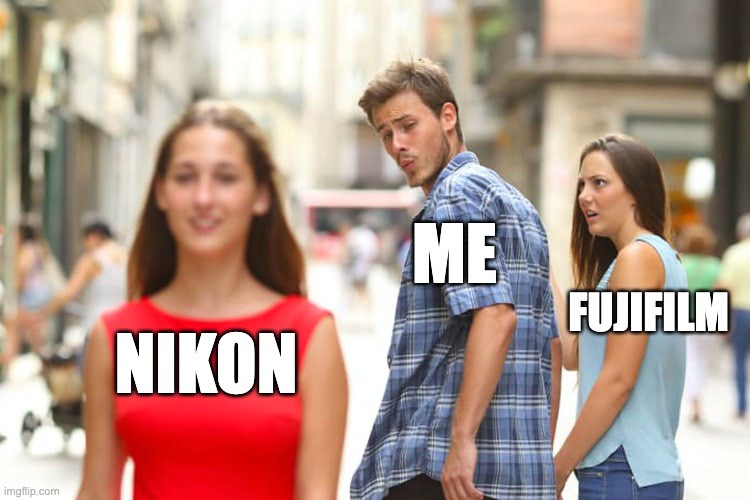
This is going to be a “stream of consciousness” subjective comparison of the “retro” Nikon Z and Fujifilm X, mostly as clarification for myself, but I hope it helps you, too 🙂 Standby for a more objective comparison of the Zfc and the X-T30 II.
There are generally a few solid reasons why photographers love Fujifilm, and it checked off all of these for me:
- Simple controls
- Straight-Out-Of-Camera (SOOC) JPGs
- Fantastic lenses
- Small size & weight
All of these combined just made the cameras fun. Lately, however, Fujifilm seems to be courting a different photographer.
Not to mention Kaizen is a thing of the past. Fujifilm is complying with the obligatory firmware updates – bug fixes and better autofocus – but no longer offers a laundry list of new features for old cameras with each new firmware version. Gotta buy the newest camera to get the new features. I’m sure they have their reasons, but this doesn’t make the brand stand out like it once did.
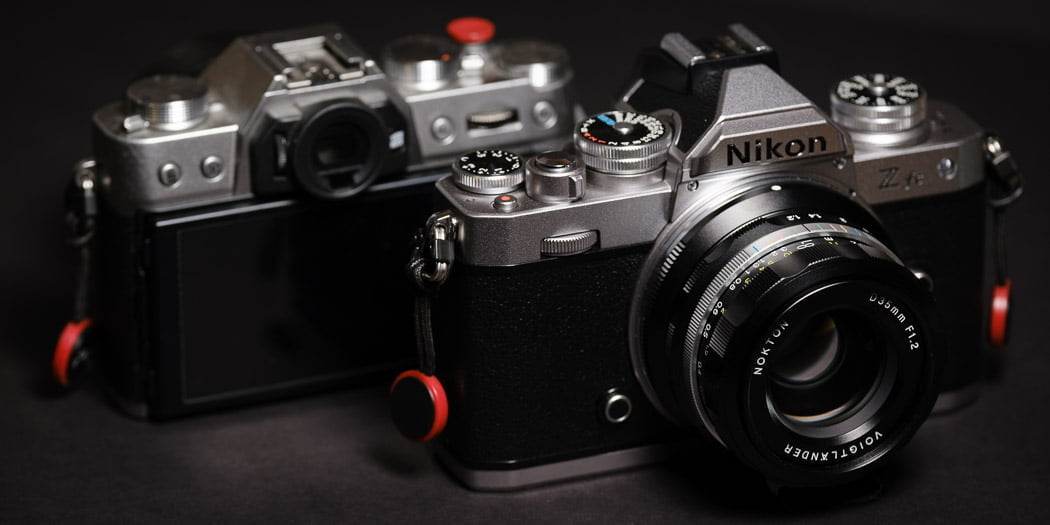
Where have Fujifilm’s simple controls gone?
Some people call them retro dials. But they’re more functional than retro.
Fujifilm’s method of controlling exposure has to be the simplest in the world. Click the aperture ring to the aperture you want. Rotate the shutter speed dial to the shutter speed you want. Ditto with the ISO dial. Set any of those to “A” to put the camera in charge of that variable.
It is the easiest, most intuitive way of manipulating the exposure triangle, especially for those of us who learned on film cameras. It has nothing to do with hipster retro fads. It’s function.

To those who say, “But you need to put the camera down to change those top dials; I can more easily change mine with the command dials,” I say, use the camera for more than a day, and you’ll see you can change all exposure controls while still looking through the viewfinder.
But Fujifilm has been putting PSAM dials on more and more of its cameras to attract a larger market. You can’t find a new GFX camera with these basic exposure controls. The X series lines without full dedicated exposure controls now equal those with them. We already saw the X-E4 ditch the controls the X-E3 had; will the other lines eventually follow?
Nikon’s addition of physical exposure control
The Nikon Zfc and Zf cameras oddly have a PSAM switch and shutter speed & ISO dials. Perhaps to make the transition for PSAM-dial users easier?
Nikon’s exposure dials are not functional in the exposure modes that don’t use them, meaning in Aperture Priority (A) mode, when the camera is in charge of shutter speed, you can rotate that shutter speed dial all day long, and it’s not going to do anything.
The ISO dial doesn’t have an automatic ISO selection, unlike Fujifilm. You need to go into the menus to activate Auto ISO. However, the Zf does have a “C” position on the ISO dial, which allows you to use a custom control with the command dials to change ISO, including AUTO, like Fujifilm.
The Nikon Zfc and Zf do have a dedicated Exposure Compensation dial like most Fujifilm cameras, with a “C” position allowing you to use the command dial.
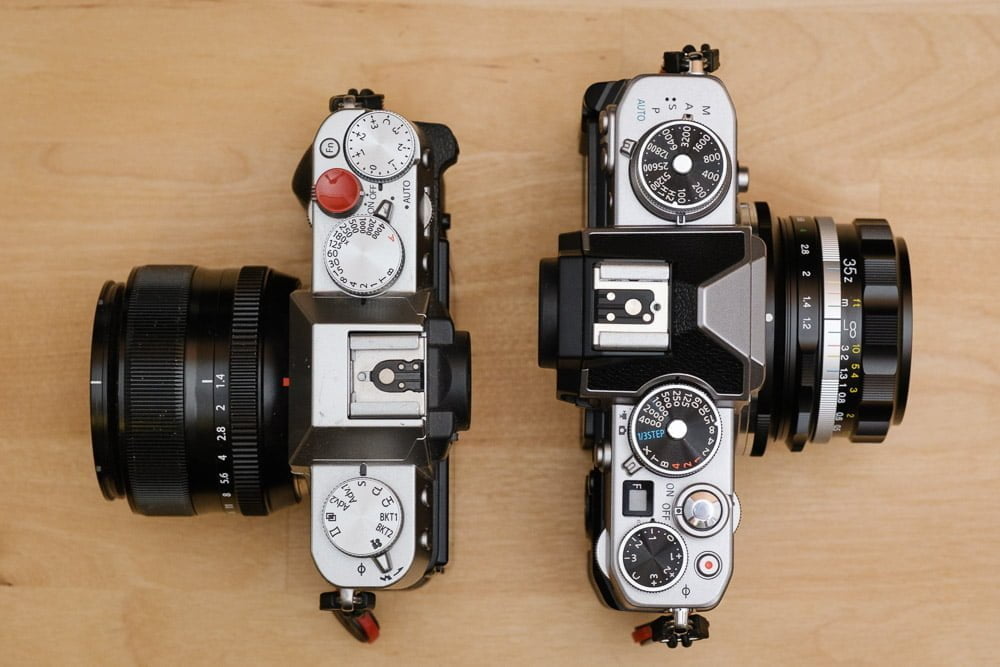
And finally, Nikon’s Z-mount lenses don’t have the aperture rings like Fujifilm (yet) – so you’re still using the command dial to adjust the aperture. Many third-party lens manufacturers do offer great lenses with inscribed aperture rings, like these Voigtlander lenses (link to B&H).
So, while Nikon’s new cameras do offer physical exposure controls, they operate a bit differently than Fujifilm.
Nikon’s menus – an organizable mess
Nikon’s menus are, compared to Fujifilm, all over the place. Like Sony, they randomly picked items from a hat when choosing where and how to place menu items.
Thankfully, you have the same menu customization in the Nikon Zfc & Zf as in Fujifilm. There’s a My Menu in both, and the Nikon i menu is similar to Fujifilm’s Q menu.

Nikon does take it one step further, though. In addition to programming My Menu, you can also put Recent in that menu. It becomes a dynamic, customized menu based on both your preferences and what you recently changed. That’s a time-saver.

SOOC JPGs
Film simulations. One of the main reasons photographers love Fujifilm and why the X100V disappeared from camera stores after influencers discovered them.
It wasn’t just how the camera handled JPGs; it was how you could take any film simulation and further customize them, changing the toning, color, and more. You could save those customizations as a “film recipe,” one of the seven Custom Settings available in the camera.
Why did this matter to photographers? It made photography fun. It made picking up and using the camera more about creativity than the technical aspects of the camera. What’s your mood? How do you want to style your photo? Pick one of your Custom Settings and pre-process the photo so you don’t have to post-process.
Fujifilm Custom Settings aren’t about styling choices anymore; they’re about technical choices. Your choice of Focus and Shooting settings now takes precedence over your image styling settings. Hey John, you can still program the styling settings to a Fujifilm Custom Setting. Yes, but you can’t use them the same way, as I outlined in this article.
Nikon’s Picture Control & Retouching
Nikon doesn’t have film simulations, but they do have Creative Picture Control. In addition to the standard Neutral, Vivid, Portrait, Landscape, etc., profiles, they now have filter-ish profiles like Somber, Dramatic, Bleached, Melancholic, and more.
They’re not film simulations, so maybe they’re not as cool. Maybe they’re for the kids or the influencers. But go into the menu to edit these profiles, change the hue, brightness, saturation, clarity, and contrast, and save it as your own preset called Velvia if that makes you feel better.
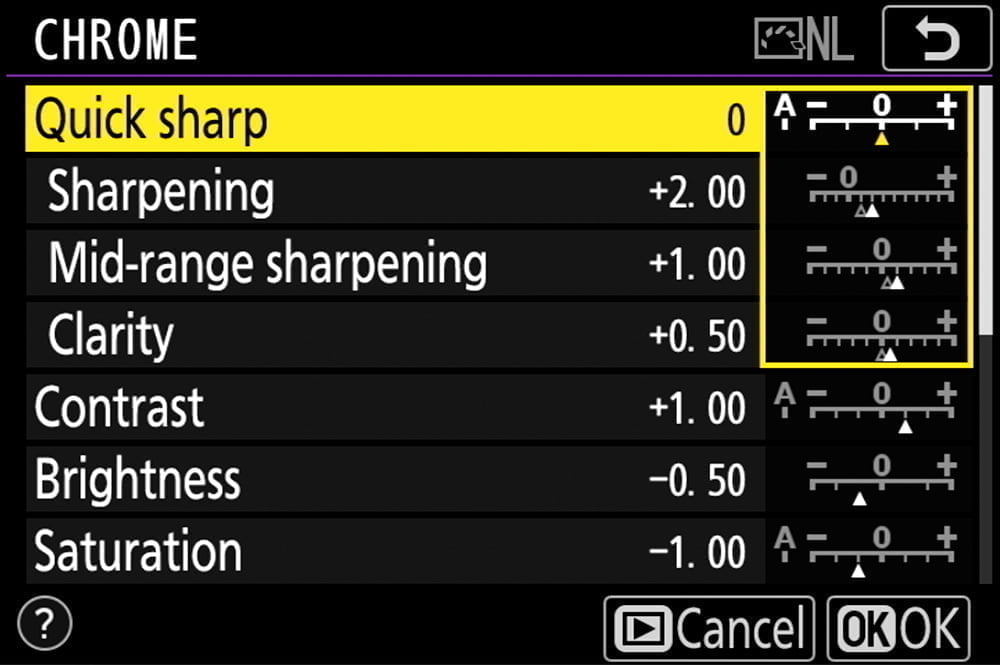
Fujifilm’s film simulations are not pure film reproductions anyway; they’re about a creative process, not a strict simulation. Add contrast to Nikon’s Bleached profile and call it Eterna Bleach Bypass. There’s no real-world film called Eterna Bleach Bypass, so who’s to say if your version is more “accurate” than Fujifilm’s?
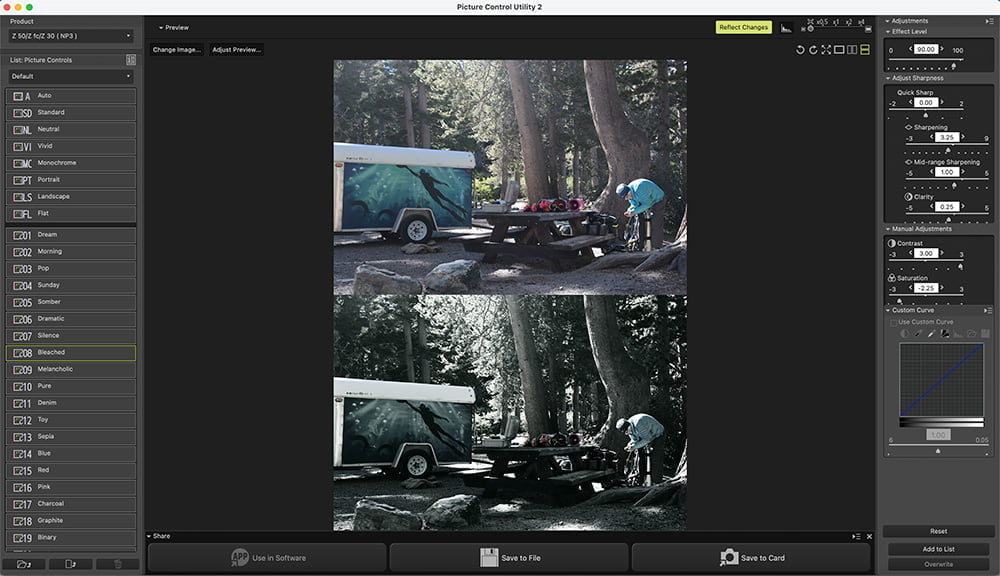
The way Nikon’s styling options are set up is more reminiscent of the older Fujifilm cameras. Take a base pre-loaded “style” and further edit it. Save it as your own named custom style. Refine it as needed for your current situation. Jump to a new styling setting appropriate for the scene or mood, as you would change a roll of film. Save/change just the styles without having to tie focus or shooting settings to it.
In Fujifilm’s newer cameras, if I think my C7 Acros style is more suitable than my C3 Classic Chrome style for a particular scene, and I switch from C3 to C7, it drives me f**king insane that my focus & shooting settings change too. That ruins the whole goddamn experience – and has made me miss many a photo. Sorry for the language; you can see how much of a fun-sponge this has been for me. Countless Fujifilm photographers across forums and other communities echo the same sentiments.
There is a vast online library of Nikon “film recipes,” just as there are Fujifilm “film recipes.” Unlike Fujifilm, though, these Nikon simulations are files that can be transferred directly into your camera. Go to nikonpc.com for some ideas (just don’t pay much attention to the preview images; they’re not very accurate). Use Nikon Picture Control Utility 2 to create your own vast library of “film simulations” on your computer.
Reviewing an image on the Nikon cameras and wish you had used a different profile? Go into the RAW Retouching menu and adjust various image processing settings, including applying an entire profile simultaneously. Even straighten and apply perspective controls in-camera.


Fujifilm’s small form factor & awesome lenses
This is where I don’t think Nikon will ever be able to touch Fujifilm – at least immediately. The Nikon Zfc, the crop sensor camera, is about the size of a Fujifilm X-T5, even though it’s more in the X-T30 class. The Nikon Zf, the full-frame model, is naturally even larger.
Nikon’s Z-mount lenses, even the crop sensor versions, are mostly larger than Fujifilm X-mount lenses. And that’s because Z mount is used on both full frame and APS-C cameras. It’s great for compatibility between the two formats but not great if you don’t care to use full-frame. The native lens selection is limited, and so is the quality.
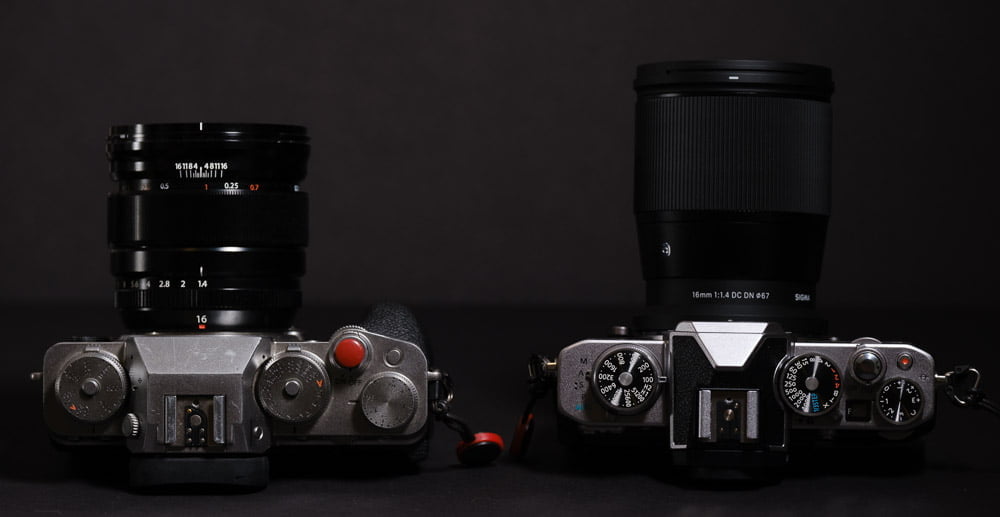
Granted, the Nikon Z system hasn’t had the time to mature as much as the Fujifilm X system. And there will always be – and are – plenty of third-party manufacturers making lenses for both. But as it stands right now, especially when choosing primes, Fujifilm X is the system to be in if this is your priority.
What’s important to you in a camera?
It’s important to not just look at numbers/specs when choosing a camera system. You need to understand how that camera will become a part of you when creating photographs. How will the camera make you feel? If the camera makes you feel frustrated or doesn’t give you a feeling of fun or joy, that will come across in your photographs. And you don’t want that, right?
You’ll create better images with a simple camera you enjoy than a high-end one you don’t.
As far as “image quality”? Countless world-renowned photographers use both the Nikon and Fujifilm systems. That’s good enough for me. I’m familiar with Nikon images (many of my students use Nikon Z), and I do like their colors & quality. At this point, it’s all personal preference.
What matters to me is having a 9-stops-of-dynamic-range camera that’s fun rather than a 10-stops-of-dynamic-range camera that isn’t, if you get me. That’s where my priorities are; I understand yours may be different. The 40MP resolution of the new X-Trans sensors is ridiculous and seems to be about bragging rights; the more I used the X-T5, the more I noticed I just didn’t like the image quality as much as the 26MP X-T4.
The future of Nikon versus Fujifilm – one photographer’s perspective
What brought me joy in using the Fujifilm system – the simple controls and custom styling options – doesn’t appear to be in the future for Fujifilm cameras. Looking at trends, Fujifilm is falling away from that, while Nikon’s latest offerings are moving toward it.
The small form factor is no longer as much of a concern to me as it was in 2016 when I switched to Fujifilm while traveling the world on foot and needed something small and fun that produced excellent images. I’m doing more locally-based documentary work now. My priorities have changed, and that’s fine. You should be okay with changing your tools to suit your job.
Does this mean I’m done with Fujifilm? Of course not. I’m just probably done upgrading. It’ll be a transition period that will likely last years, and I will have to look at the trends to see where that transition is headed. I’m heavily invested in the Fujifilm system in money, knowledge, and community, and I don’t want to give that up spontaneously.
My older Fujifilm cameras are still fun. The lenses are great. But I realistically can’t stick with the same digital camera for the rest of my career. If future Fujifilm cameras won’t be as fun or functional for me, it’s worth looking at another system as a long-term solution. That’s life. And it’s why Nikon has me excited as a potential creative partner with this new line of cameras that feel like cameras.
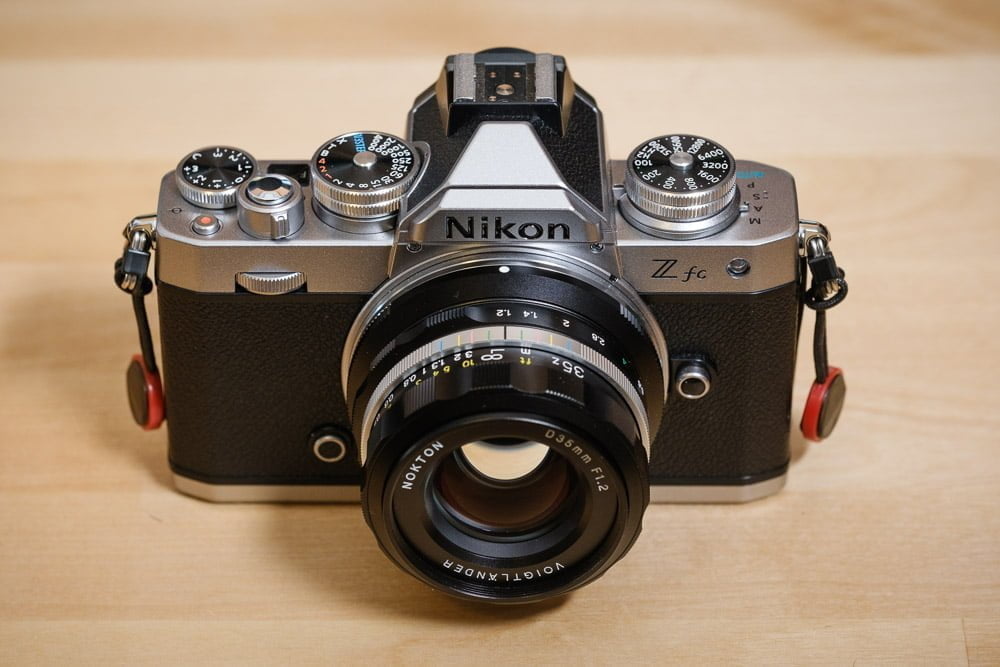
Has anyone else switched or thought about switching between Fujifilm X and Nikon Z? Please share your experiences!

McMuppet
Wednesday 21st of February 2024
Hey - found you as I just bought an x-t5. Most fun I've had with a camera for a long time, but haven't experienced the evolution of models since the t1 so perhaps that's why I'm only pleased with my Fujifilm experience so far.
Will you still be updating Fujifilm courses etc. Not sure how long ago the switch to Nikon was and whether course content is up to date etc.
Btw - Nikon is an awesome brand too. My brother is a Nikon photographer (and much better at photography than I) and he loves the brand.
McMuppet
Wednesday 21st of February 2024
@John Peltier, Brilliant. Will sign up and do some courses. Cheers.
John Peltier
Wednesday 21st of February 2024
Glad you’re enjoying it! That’s a rockstar of a camera. I’m not completely giving up on Fujifilm, in fact, I just bought an X100VI and will be doing a course on that camera, and just started an update on one of my older Fujifilm courses. Still here!
Sleeping Dog
Saturday 6th of January 2024
A few years ago, I returned to photography as a hobby, settling on an XT30 for the classic controls, size and film simulations. But as I've thought about the "next" camera, where Fujiflim has gone is of less interest. My most likely Fuji possible, would be an X-pro 3, used after the X-pro 4 comes out, I don't need or for that matter want 40 mega pixels.
But I'm also having thoughts about others, and not Nikon. The Pixii intrigues me and I had a chance to shoot a friends Leica M10--D, so that or the older M-D Type 262 keep crossing my mind.
First world problems.
John Peltier
Sunday 7th of January 2024
First world problems indeed ;) The Leica M11 Monochrome has been in my sights for quite some time, if only I could justify the cost!
Martin
Thursday 14th of December 2023
I'm still an owner of D750 and past-owner of Z6 wich was with newest firmware 3.40.
My wish list for Z cameras was: 1. ADD quick way to switch Shutter Speed with AUTO-ISO function (none) 2. ADD virtual horizon known from DSLR (from Z9 only) 3. ADD lock-lever switch on body to lock focus point position known from DSLR (from Z9 only) 4. ADD zebra in photo mode (none) 5. ADD eye/face detection on/off switch (none) 6. ADD clean view in LCD or EVF (from Z6ii/Z7ii) 7. ADD crop frames when you choose different crop mode for example 16:9 (from Z9 only) 8. ADD DX-mode frames in viewfinder, now it just magnifying the view instead of drawing a frame of DX-format (none) 9. ADD distance scale with mt/ft, now its just a simple bar without info (none)
It all could be easily fix or add by firmware updates. I wasn't mind if Z6 would slow down with above updates because it has 'only' one processor. But NIKON forgot about us - Z6 users.
So I trade all Z-gear and some of F-glass and made a switch last year to X-T4 which checks all the boxes and more.
It is more wider topic to talk about, not via web-site comment, but looking back to all of my 'switches' (300D>D80>D300s>D750>Z6>XT4) in past 18 years I realize with the last one that I don't evolve as photographer at all. So I left myself D750 with 24-70VR as it was my dream come true camera: full-frame dSLR. He will be sitting in the drawer just as a reminder to never switch again to anything and use to use what I've got already.
John Peltier
Tuesday 26th of December 2023
Nice list! My workaround for quickly switching shutter speed while using Auto ISO is to just pop the camera in to Manual exposure mode with a fixed shutter speed, if I need something faster. Seems like most of those would be easy additions, as you mentioned. If what you have is working for you, stick with it :)
Patrick
Wednesday 13th of December 2023
Nice article! The main reasons for me to move from Nikon DX to Fujifilm several years ago were the smaller size, the tactile experience and the Kaisen philosophy. I am certainly disappointed with the lack of firmware update but I will continue to use my Fuji equipment a bit longer for budget reasons. I just wanted to share an article from Digital Camera World about a new adapter allowing to use Fuji lenses on Nikon Z APS-C bodies. This might bring more options if you already have Fuji lenses. https://www.digitalcameraworld.com/news/40-new-lenses-for-nikon-z-aps-c-users-it-is-possible-thanks-to-a-smart-fujifilm-x-adapter?
John Peltier
Wednesday 13th of December 2023
Oh that's awesome about the adapter, I might have to check that out! Looks like it's brand new. If you've got a system that works for you and you're happy with it, save that money!
Mark Seawell
Wednesday 13th of December 2023
I've been with Fuji since 2018 when I bought the X-T2 and moved from the M43 system. One of the reasons I transitioned is because I was losing my love of photography so I get it. I still have my X-T2, owned the X-T4 and traded it for the X-T5 this summer. But to your point John, Kaizen is dead. The Fui leadership has definitely changed and is more profit driven. If or when I move on it would be to Nikon no doubt so I wish you well in your journey and maybe one day I will join you in that world.
John Peltier
Wednesday 13th of December 2023
Tough choices all around, Mark :) Wasn't easy for me either. But we have to do what we have to do to make photography enjoyable to us as individuals! Good luck and let me know if you have any questions about either Nikon or Fujifilm system.